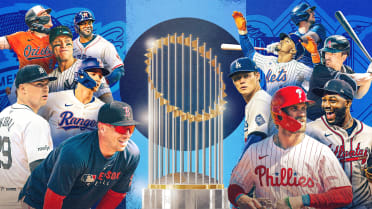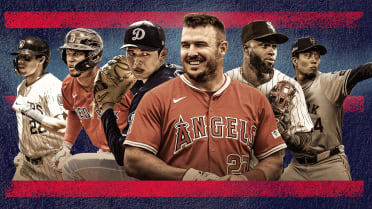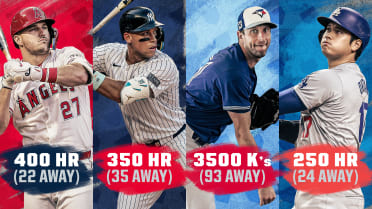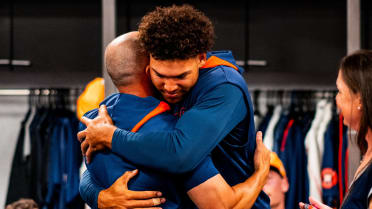Most great pitchers have that pitch. You know the one – whether it's a high-octane fastball, a wipeout slider or a really good 12-6 curve, it's the pitch that dominates the discussion around that player's arsenal and, if all goes well, remains iconic for years to come. You’re probably already thinking of a few. And while there’s no one way to be a successful Major Leaguer, without a doubt, having that elite pitch in the back pocket can change everything for a pitcher.
A number of new or previously under-the-radar pitches have made an impression early on in 2023, keeping hitters on their toes with increased movement or better location. Here’s a look at five of those new and improved pitches that have been some of the best in the first month of the season, and what’s made them special.
Joe Ryan, Twins -- splitter
Often what follows a strong rookie season is concern over a potential sophomore slump. That was a particularly strong possibility for Ryan, who in 2022 was an excellent fastball pitcher without a strong breaking or offspeed pitch. In 2023, he’s mostly scrapped all three of last year’s secondary pitches – a slider, curveball and changeup – and replaced them with a splitter and a sweeper, and while he threw a few sweepers in 2022, his splitter is brand new – and it looks like a game-changer.
Ryan almost exclusively works up with his four-seamer, with his breaking and offspeed stuff living in the lower third of the zone and below. This worked for him in 2022 – the only issue, of course, was the relative weakness of his secondary pitches, which yielded a collective .258 batting average and .438 slugging percentage. His new splitter, on the other hand, which he’s throwing in the same lower third 74.7% of the time, has yielded a 66.7% ground ball rate and a .116 BA (5-for-43, 0 XBH.)
There are improvements he’ll have to make to this pitch, with the inflated 45.5% hard-hit rate against it being a potential issue. But if we view his first six starts of the season as a trial run for his new arsenal, it’s clear the splitter has made a major improvement.
Roansy Contreras, Pirates -- slider
The Pirates have gotten off to an excellent start. Complicating the possibility of a much earlier return to the postseason than most had anticipated are the teams just behind them – the Brewers, sitting 1.5 games out of first, and the Cubs, four games behind. While the Pirates stack up favorably against their closest competition in some ways – their bullpen, for one, has been considerably stronger – one particular shortcoming they face is the relative strength of their rotation. This could be where Contreras comes in.
Contreras is 23, and the Pirates are no doubt hoping that this will be the year he makes it through his first full season in the Majors. They’ve done him a favor in that regard by putting an emphasis on their pitchers leaning heavily into their strengths in 2023. For Contreras, that’s meant throwing more sliders – 48.2% of them, a 14-point increase from 2022. And, with a bit more movement (he’s getting almost three inches of additional break on the pitch on average) hitters have struggled to keep up, posting a .188 SLG against the slider, which has heavily contributed to his vastly improved 36.5% hard-hit rate. Of his 27 strikeouts, 23 have come against his slider, and it has a run value of -9, which ranks second in baseball, in stark contrast with the four-seamer (+7 runs) he’s pulled back on.
Jason Foley, Tigers -- sinker
Foley’s sinker is not a new pitch, but the Tigers gave us little reason to take note of individual pieces in their bullpen last season. The early misfortune of a few of Detroit’s division rivals merits at least another look at the Tigers, who have a pair of relatively anonymous lights-out relievers in their bullpen. Closer Alex Lange is one; Foley is the other.
Sinkers are meant to draw contact, which creates an issue both when they’re thrown around the heart of the plate and when they’re easy takes. Foley dealt with a bit too much of both in 2022. This season, he’s had a 6.6% increase in sinkers in the “shadow” of the strike zone, which has kept hitters from getting underneath them as often. His ground-ball rate is up over 13 points, to 70.6%, and to this point, Foley’s sinker has a run value of -7 (T-9th) – especially outrageous given he’s a reliever – and the diminished quality of contact has its expected batting average down to .234 after it hung up at .263 in 2022.
Ian Hamilton, Yankees -- slider
Hamilton made his Major League debut in 2018, just two years after he was drafted in the 11th Round by the White Sox in 2016. His career was then derailed by what might be the most hard-luck year in the history of professional baseball. He dealt with a series of injuries early in 2019, capped off by a freak incident in which he was struck in the face by a foul ball while sitting in the dugout. He then underwent a series of eight surgeries to repair injuries to his jaw and mouth. All told, despite the promising start to his career, coming into this season he’d racked up just 14 2/3 innings in the Majors and cycled through five organizations. Point being, after all of that, it’s an accomplishment in and of itself that Hamilton is in a big league bullpen at all, particularly after reporting to Spring Training as a non-roster invitee.
Hamilton has, so far, been one of the Yankees’ most-used – and most effective – relievers, and he’s gone about it in an unexpected way. As a prospect, Hamilton was known for having a live arm, but in the early going this season, it’s been all about his slider. He’s using it 55.3% of the time (especially high, it should be noted, for a right-handed pitcher), and with good reason, given its 40.2% whiff rate. He’s already racked up 19 strikeouts on sliders, third-most among relievers. On those relatively rare occasions hitters have made contact, the results haven’t been much better – the pitch has an average exit velocity of 86.2 mph. Hamilton, overall, has a sparkling 1.42 ERA and 0.89 WHIP, which have him keeping pace with some of the AL's best.
Justin Steele, Cubs -- four-seam fastball
The Cubs have quietly been playing some of the best baseball the North Side has seen in years. Leading the charge in their solid start has been their rotation, and leading that rotation has been Steele, who ranks third among qualified pitchers in ERA (1.49) and has opponents hitting .196 against him. You might recall Steele having a strong, though abbreviated, 2022 season. But he couldn't do much to carry the Cubs' rotation, and his four-seamer, which he threw 56.4% of the time, yielded a .312 batting average. He’s still relying heavily on that pitch, but the results have been night and day.
To call Steele’s four-seamer versatile would be a gross understatement. His velocity on the pitch ranges between 88 and 94 mph, his release point varies significantly, and most interestingly, it can break in either direction, as much as eight inches to his glove side or five inches arm side. Plenty of four-seamers move more than that, but few are less predictable. But that was also true last season. That his fastballs are landing in the heart of the zone quite a bit less this year – a dip of five points through his first six starts – has made a difference, making it even more difficult for hitters to anticipate them.
Shanthi Sepe-Chepuru is a reporter for MLB.com.




